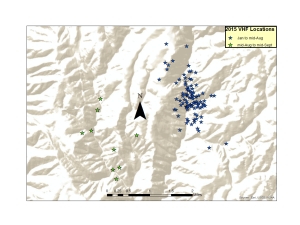For much of the spring and early summer, the job of tracking most of the female fishers isn’t all that difficult. Denning females spend a lot of time in their dens, so we usually have a specific point for starting our searches. When they go out foraging, we know they will need to return to their den eventually, and often aren’t found too far away from these sites.
As we move into June and July, the kits grow quickly and become more mobile. The time spent in any one den becomes shorter, and females are out and about more and more. Keeping track of them starts to become more difficult. Once August rolls around, we often observe some larger movements, many of which take the females outside of the areas we have tracked them over the last many months.
This pattern of females making larger moves around this time is something we notice every year, but the reason is not fully known. Possibly, this has to do with them depleting the easy food sources closest to their dens, and these moves take them to better hunting grounds.
Another hypothesis for this move is that females are taking their kits to the edges (or outside) of their ranges to let them become familiar with an area for them to “disperse” to. Especially for any juvenile males, it is not advantageous for them to remain near their mom’s home range, so making a move to get the kits away from her range makes sense. Whatever the reason, it’s fun (although often frustrating) to track them in some different areas.
By now, the juveniles should be very close to dispersing (if they haven’t already) and being on their own. We will begin our trapping efforts in a few weeks, and it will be exciting to see if we can capture some of these youngsters, especially in the areas that we are seeing the adult females traveling to.



